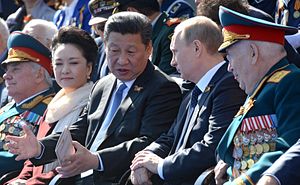Trans-Pacific View author Mercy Kuo regularly engages subject-matter experts, policy practitioners, and strategic thinkers across the globe for their diverse insights into U.S. Asia policy. This conversation with Dr. Sarah Kirchberger – head of the Center for Asia-Pacific Strategy and Security at the Institute for Security Policy at Kiel University (ISPK) in Germany and senior research associate with the Faculty of East Asian Studies, University of Bochum – is the 114th in “The Trans-Pacific View Insight Series.”
Explain the background of the U.S.-EU arms embargo on China.
The embargo was imposed after China’s government ordered a military crackdown against unarmed protesters in June 1989. It remains in place despite Chinese protests over its supposed “unfairness,” and despite occasional lobbying from European defense industries to ease the restrictions. Whereas the U.S. embargo is legally binding, the EU leaves the concrete implementation to each member country, leading to different interpretations. There’s not much awareness in Europe concerning these differences and their implications, and EU countries would do well to harmonize their approach.
The embargo disrupted several Chinese procurement projects that had been designed around Western components that suddenly became unavailable – such as American gas turbines for naval surface vessels. It forced China to reverse-engineer old imported systems and to start indigenous arms development from a relatively backward basis. Furthermore, while most advanced weapons producers today engage in transnational collaborative arms production, China’s choices remain fairly limited. This made Russia, and to some extent Ukraine, an obvious source of military technologies that China could not yet develop on its own.
How has China benefited from the break-up of defense-industrial ties between the military industrial complexes of Russia and Ukraine after the Crimea crisis?
After the breakup of the Soviet Union, Ukraine inherited strategic arms production facilities specializing, for example, in heavy missile parts, transport aircraft, jet engines, naval gas turbines and armored vehicles. Ukraine and Russia entered into a near-symbiotic arms-producing relationship, and Russia leased the Sevastopol naval base and the NITKA aircraft carrier pilot training center on Crimea. The 2014 breakup of this arrangement proved highly disruptive. Both countries lost at once their most important arms supplier and a major export market. Overcapacities in Russia and Ukraine have put pressure on cash-strapped industries to quickly find new customers, and China is able to take advantage of that.
Furthermore, political incentives favor a reorientation toward the Chinese market in both Russia and Ukraine. Western sanctions make China an important political and economic counterweight that allows Russia to weather the impact better, while Ukraine needs to secure external support against further Russian transgressions. With NATO or EU accession not a realistic option in the near future, and given continued Russian aggression, China’s support is potentially a valuable lever to Ukraine.
With China’s aim to build a world-class military, as China’s recent 19th National Party Congress confirmed, what is the China’s role in the transnational arms production market?
China has become the world’s third largest arms exporter after the U.S. and Russia. Qualitatively, there has been a shift from low-tech arms sold to poor developing countries to transferring relatively complex systems (naval vessels and fighter aircraft) to middle-income countries. China recently won contracts against Western competition in Algeria, Pakistan, and Thailand. With the quality of Chinese arms steadily improving, and given an attractive pricing and financing policy, China can be expected to gain an even larger market share in the future – especially among countries that procure arms systems from Russia and that participate in China’s Belt and Road Initiative (BRI). BRI combines strategically relevant projects in infrastructure, energy production, and military development into attractively financed packages, and this can make large and costly projects easier to implement. Strong arms trade relationships with countries along the BRI can greatly improve China’s international standing, create goodwill and give China better access to resources, which are all necessary conditions for a global military presence.
How will the transfer of critical weapon technologies impact international security policy?
Critical technologies have a huge impact on operational capabilities, because they enable a key function that would otherwise be unavailable. To give an example: China had decisive Ukrainian help for designing its first indigenous phased-array radar system, which formed the cornerstone of the Chinese equivalent to the U.S. Aegis combat system. This was an important step toward net-centric operations and a precondition for China’s naval expansion, as the protection of carrier strike groups requires such a capability.
But there are also civilian dual-use-technologies that enable critical military functions. China has secured technology transfers from Western countries in several such areas, including specialized equipment for oceanography and hydrographic surveys that is needed to prepare submarine operations, and in space technologies – satellite constellations and data download stations being a key factor for early warning, navigation, surveillance, and targeting. Often it is difficult for governments and industries to anticipate the unintended consequences that a dual-use technology transfer can potentially have. This is an area that deserves far more scrutiny than it currently receives.
What is the impact of this military-industrial triangle on U.S. security interests?
The Western sanctions against both Russia and China, their necessity notwithstanding, have the unfortunate side-effect of forcing both countries to exploit their synergies. We can see increasing collaboration in arms production, raw materials extraction, political cooperation in the international arena, and even in the development of similar “hybrid” strategies against Western military dominance. Sino-Russian military exercises are now regularly conducted even in NATO’s home waters. Although this is probably a marriage of convenience rather than a genuine love affair, this collaboration, especially when seen in conjunction with the Belt and Road Initiative, could still become a strategic problem for NATO and the U.S. if it further deepens.
































